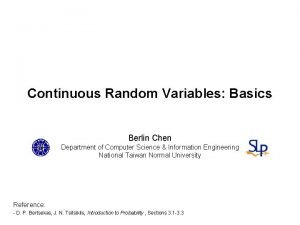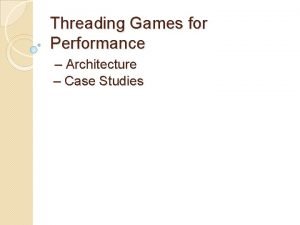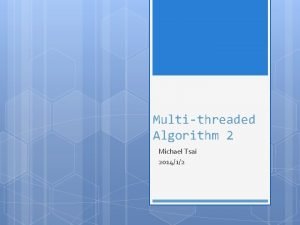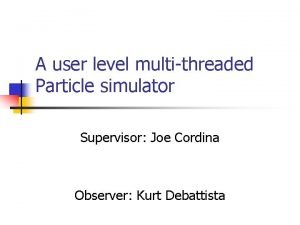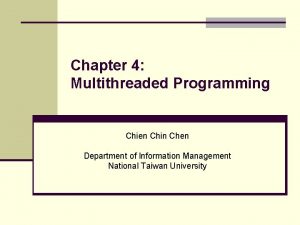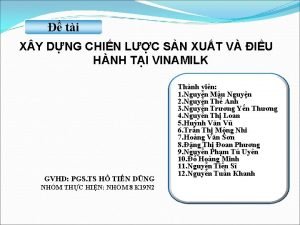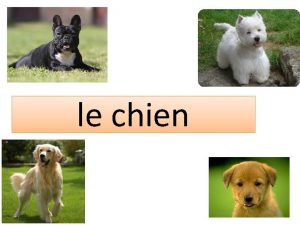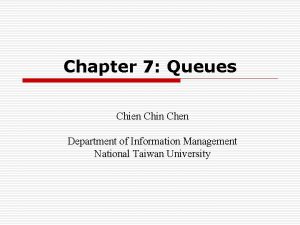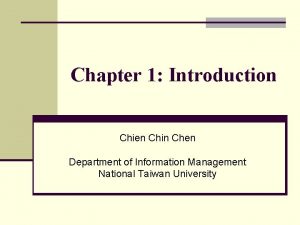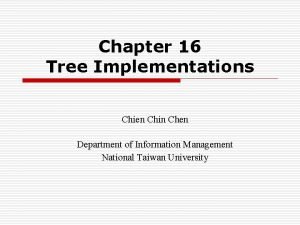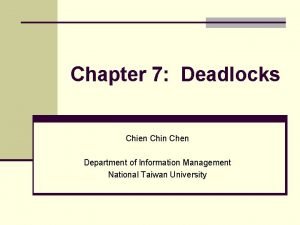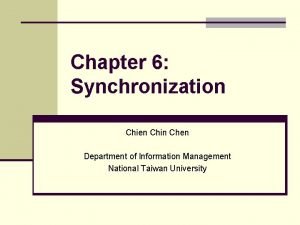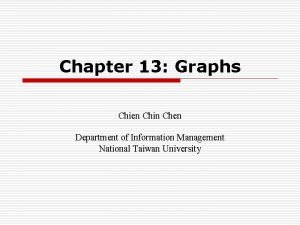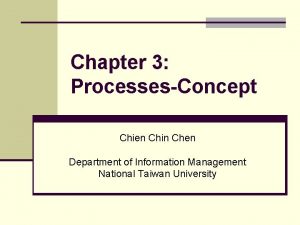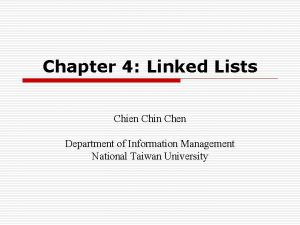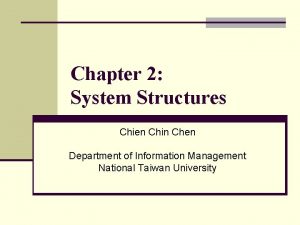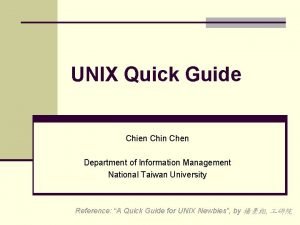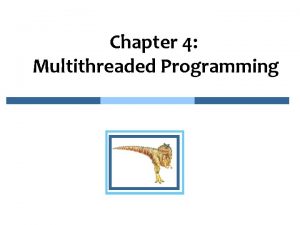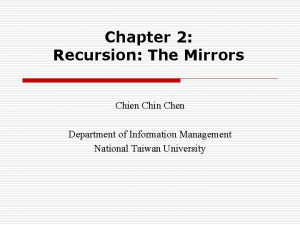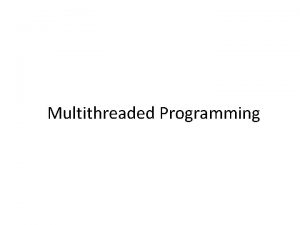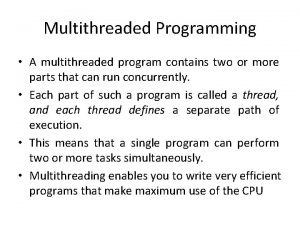Chapter 4 Multithreaded Programming Chien Chin Chen Department










































- Slides: 42

Chapter 4: Multithreaded Programming Chien Chin Chen Department of Information Management National Taiwan University

Outline n Overview. n Multithreading Models. n Thread Libraries. n Threading Issues. n Operating-System Examples. 2

Overview (1/6) n Single-threaded process – multithreaded process: n n n A thread is a basic unit of CPU utilization. Traditional process has a single thread of control. Multithreaded process can perform more than one task at a time. n Many applications are multithreaded. n n A web browser might have one thread display images while another thread retrieves data from the network. A word processor may have a thread for responding to keystrokes from the users, and another thread for performing spelling and grammar checking in the background. 3

Overview (2/6) n In many situations, an application may be required to perform several similar tasks. n n A web server accepts several client requests for web pages. If the web server ran as a traditional single-threaded process … it would be able to service only one client at a time. n Solution 1: n When the server receives a request, it creates a separate process to service that request. n n n E. g. , fork(). This process-creation method was in common use before threads became popular. Process creation is time consuming and resource intensive. n Solution 2: n It is more efficient to use one process that contains multiple threads. n When a request was mad, the server (a thread) would create another thread to service the request. 4

Overview (3/6) n A thread comprises: n n A thread ID. A program counter. A register set. A stack. n It shares with other threads belonging to the same process: n n n Code section. Data section. Other operating-system resources, such as open files. 5

Overview (4/6) 6

Overview (5/6) n Benefits: n Responsiveness: n n n Resource sharing: n n Threads share the memory and the resources of the process to which they belong. Economy: n n n Application can continue running even if part of it is blocked or is performing a lengthy operation. A multithreaded web browser allow user interaction in one thread while an image was being loaded in another thread. Allocating memory and resources for process creation is costly. In Solaris, creating a process is about thirty times slower than is creating a thread. Context switching is about five times slower. Utilization of multiprocessor architectures: n n Threads may be running in parallel on different processors. A single-threaded process can only run on one CPU, no matter how many are available. 7

Overview (6/6) n Many operating system kernels are now multithreaded. n n n Several threads operate in the kernel. Each thread performs a specific task. For example, Linux uses a kernel thread for managing the amount of free memory in the system. 8

Multithreading Models (1/7) n User threads – kernel threads: n n User threads are supported above the kernel and are managed without kernel support. Kernel threads are supported and managed directly by the operating system. n All contemporary operating systems support kernel threads. n There must exist a relationship between user threads and kernel threads. 9

Multithreading Models (2/7) n Many-to-One model: n n Map many user-level threads to one kernel thread. Thread management is done by the thread library in user space. n The library provides the supports of thread creation, scheduling … n Is efficient, because there is no kernel intervention. n But … as the kernel is not aware of user threads … The entire process will block if a thread makes a blocking system call. Multiple threads are unable to run in parallel on multiprocessors. n n 10

Multithreading Models (3/7) Many-to-One model 11

Multithreading Models (4/7) n One-to-One model: n Map each user thread to a kernel thread. n Allow another thread to run when a thread makes a blocking system call. n Allow multiple threads to run in parallel on multiprocessors. n n But … creating a user thread requires creating the corresponding kernel thread. The creation overhead can burden the performance of an application. Most implementations of this model restrict the number of threads supported by the system. Supported by Linux and Windows family. 12

Multithreading Models (5/7) One-to-One model 13

Multithreading Models (6/7) n Many-to-Many model: n n n Multiplex many user-level threads to a smaller or equal number of kernel threads. The number of kernel threads may be specific to either a particular application or a particular machine. The many-to-many model does not suffer from the shortcomings of the previous two models. n n n Many-to-One: the kernel can schedule only one thread at a time (on a multiprocessor system). One-to-One: the number of threads is limited. Many-to-many model 1. allows as many user threads as necessary, and 2. the corresponding kernel threads can run in parallel on a multiprocessor. When a thread is blocked, 3. the kernel can schedule another thread for execution. 14

Multithreading Models (7/7) Many-to-Many model 15

Thread Libraries (1/11) n A thread library provides the programmer an API for creating and managing threads. n Two ways of implementing a thread library: n To provide a library entirely in user space with no kernel support. n n n All code and data structures for the library exist in user space. All function calls result in local function calls in user space; and no system calls. To implement a kernel-level library: n n n Supported by the operating system. Code and data structures for the library exist in kernel space. A function cal in the API for the library results in a system call to the kernel. 16

Thread Libraries (2/11) n Three primary thread libraries: n POSIX Pthreads. n n Win 32 threads. n n May be provided as either a user- or kernel-level library. Kernel-level library, available on Windows systems. Java threads. n n n JVM is running on top of a host operating system, the implementation depends on the host system. On Windows systems, Java threads are implemented using the Win 32 API; UNIX-based systems often use Pthreads. n The following multithreaded examples perform the summation of a non-negative integer in a separate thread. User specified 17

Thread Libraries – Pthreads (3/11) n Pthreads refers to the POSIX standard, defining an API for thread creation and synchronization. n n n Is a specification for thread behavior, not an implementation. Operating system designers implement the specification in any way they wish. When a program begins, a single thread of control begins in main() then creates a second thread. In a Pthreads program, separate threads begin execution in a specified function – in this example, the runner() function. 18

Thread Libraries – Pthreads (4/11) void *runner(void *param) { int i, upper = atoi(param); sum = 0; A global variable shared with main() if (upper > 0) { for (i = 1; i <= upper; i++) sum += i; } pthread_exit(0); Thread termination } 19

#include <pthread. h> #include <stdio. h> All Pthreads programs must include this header file. Thread Libraries – Pthreadsthrd-posix. c (5/) int sum; /* this data is shared by the thread(s) */ void *runner(void *param); /* the thread */ int main(int argc, char *argv[]) { pthread_t tid; /* the thread identifier */ pthread_attr_t attr; /* set of attributes for the thread */ if (argc != 2) { fprintf(stderr, "usage: a. out <integer value>n"); return -1; } if (atoi(argv[1]) < 0) { fprintf(stderr, "Argument %d must be non-negativen", atoi(argv[1])); return -1; } /* get the default attributes */ Use default thread attributes. pthread_attr_init(&attr); /* create thread */ pthread_create(&tid, &attr, runner, argv[1]); Create a separate thread /* now wait for the thread to exit */ pthread_join(tid, NULL); The parent thread waits for child to complete. printf("sum = %dn", sum); } 20

Thread Libraries – Win 32 (6/11) n A Win 32 multithreaded operation will usually be embedded inside a function which returns a DWORD and takes a LPVOID as a parameter. n n The DWORD data type is an unsigned 32 -bit integer. LPVOID is a pointer to a void. n Data shared by the separate threads are declared globally. 21

Thread Libraries – Win 32 (7/11) /* the thread runs in this separate function */ DWORD WINAPI Summation(LPVOID Param) Is identical to void * { DWORD Upper = *(DWORD *)Param; Unsigned 32 -bit integer for (DWORD i = 0; i <= Upper; i++) Sum += i; return 0; } A global variable, shared by the thread(s) 22

#include <stdio. h> #include <windows. h> Must include this header file thrd-win 32. c Thread Libraries – Win 32 (8/) DWORD Sum; /* data is shared by the thread(s) */ int main(int argc, char *argv[]) { DWORD Thread. Id; HANDLE Thread. Handle; int Param; A windows system resources, such as file and thread, are represented as kernel object. Objects are accessed in Windows programs by handles . . . // do some basic error checking Param = atoi(argv[1]); if (Param < 0) { fprintf(stderr, "an integer >= 0 is required n"); return -1; } Creation flags, default values make eligible to be run by Default stack size Default security attributes the CPU scheduler // create thread Thread. Handle = Create. Thread(NULL, 0, Summation, &Param, 0, &Thread. Id); Parameter to thread function Thread function if (Thread. Handle != NULL) { Wait. For. Single. Object(Thread. Handle, INFINITE); Close. Handle(Thread. Handle); printf("sum = %dn", Sum); } } 23

Thread Libraries – Java (9/11) n All Java programs comprise at least a single thread of control. n n E. g. , the main() method runs as a single thread in the JVM. class Summation implements Runnable { private int upper; private Sum sum. Value; public Summation(int upper, Sum sum. Value) { this. upper = upper; this. sum. Value = sum. Value; } To create Java threads, n First define a class that implements the Runnable interface. n The interface has a function run() that the class must implement. public void run() { int sum = 0; for (int i = 0; i <= upper; i++) sum += i; class Sum { private int sum; public int get() { return sum; } public void set(int sum) { this. sum = sum; } } sum. Value. set(sum); } } 24

Thread Libraries – Java (10/11) n n n Then, create an object instance of the Thread class and passing the constructor a Runnable object. Creating a Thread object does not create the new thread; it is the start() method that actually creates the new thread. The join() method in Java provides similar functionality to the pthread_join() and Wait. For. Single. Object(). public class Driver { public static void main(String[] args) {. . . // do some basic error checking Sum sum. Object = new Sum(); int upper = Integer. parse. Int(args[0]); Driver. java Thread worker = new Thread(new Summation(upper, sum. Object)); worker. start(); worker. join(); System. out. println("The sum of " + upper + " is " + sum. Object. get()); } } 25

Thread Libraries – Java (11/11) n Calling the start() method does two things: n n It allocates memory and initializes a new (child) thread in the JVM. The child thread begins execution in the run() method. 26

Threading Issues – fork() and exec() System Calls (1/15) n If one thread in a program call fork() … n n Does the new process duplicate all threads? Or is the new process single-threaded? n Some UNIX systems have chosen to have two versions of fork(), one that duplicates all threads and another that duplicates only the thread that invoked the fork() system call. n If a thread invokes the exec() system call, the program specified in the parameter to exec() will replace the entire process – including all threads. 27

Threading Issues – fork() and exec() System calls (2/15) n For systems with two versions of fork(): n n If exec() is called immediately after forking, duplicating only the calling thread is appropriate. If the separate process does not call exec() after forking, the separate process should duplicate all threads. 28

Threading Issues – Cancellation (3/15) n Thread cancellation is the task of terminating a thread before it has completed. n Examples: n Multithreaded database search: n n When one thread returns the result, the remaining threads might be canceled. A user presses a stop button on a web browser: n n A web page is often loaded using several threads. When stop, all threads loading the page are canceled. n A thread that is to be canceled is often referred to as the target thread. 29

Threading Issues – Cancellation (4/15) n Two general approaches: n Asynchronous cancellation terminates the target thread immediately. n n Canceling a thread asynchronously may not free a system-wide resource. Deferred cancellation allows the target thread to periodically check if it should be cancelled. n n n One thread indicates that a target thread is to be canceled. § Probably by setting a flag to the target thread. Cancellation occurs only after the target thread has checked a flag to determine if it should be canceled or not. This allows a thread to be canceled safely (in an orderly fashion). 30

Threading Issues – Signal Handling (5/15) n Signals are used in UNIX systems to notify a process that a particular event has occurred. n Procedure of signal handling: n A signal is generated by the occurrence of a particular event. n A generated signal is delivered to a process. n Once delivered, the signal must be handled. n Two types of signals: n Synchronous signals: n n n Signals are delivered to the same process that performed the operation that caused the signal. For instance, illegal memory access. Asynchronous signals: n n Signals delivered to a process are generated by an event external to the running process. For instance, user presses <control><C> to terminate a process. 31

Threading Issues – Signal Handling (6/15) n Every signal may be handled by one of two possible handlers: n A default signal handler. n n Run by the kernel when handling signals. A user-defined signal handler. n Default action can be overridden by programmers to call a userdefined handler. n Handling signals in single-threaded programs is straightforward. However, delivering signals is more complicated in multithreaded programs. n Where should a signal be delivered? 32

Threading Issues – Signal Handling (7/15) n Options: n n Deliver the signal to the thread to which the signal applies. Deliver the signal to every thread in the process. Deliver the signal to certain threads in the process. Assign a specific thread to receive all signals for the process. n The method for delivering a signal depends on the type of signal generated. n n Synchronous signals need to be delivered to the thread causing the signal and not to other thread in the process. For many cases, asynchronous signals (such as <control><C>) should be sent to all threads. 33

Threading Issues – Signal Handling (8/15) n POSIX Pthreads provides the pthread_kill(pthread_t tid, int signal) to send a signal to a specified thread. n kill(pid_t pid, int signal), a standard UNIX function for delivering a signal to a process. n Signals are defined in <signal. h> n E. g. , SIGKILL – (abnormal) terminate a process or a thread. 34

Threading Issues – Thread Pools (9/15) n In a multithreaded web server, the server creates a separate thread when it receives a request. n Whereas creating a separate thread is certainly superior to creating a separate process, a multithreaded server nonetheless has potential problems. n n The amount of time required to create thread prior to servicing the request. If we allow all concurrent requests to be serviced in a new thread, unlimited threads could exhaust system resources. n A better way to implement a server is to use a thread pool. 35

Threading Issues – Thread Pools (10/15) n A process creates a number of threads at process startup. n The threads sit in a pool and wait for work. n When a server receives a request, it awakens a thread from this pool – if one is available – and pass it the request to service. n If the pool contains no available thread, the server waits until one becomes free. (usually line in a queue) n Once the working thread completes its service, it returns to the pool and awaits more work. n Advantages of thread pools: n Servicing a request with an existing thread is usually faster than waiting to create a thread. n Pools limit the number of thread. This is important on systems that cannot support a large number of concurrent threads. 36

Threading Issues – Thread Pools (11/15) n The number of threads in the pool can be set heuristically. n For example, a pool can have 25 threads/CPU. n Some thread-pool architectures can dynamically adjust the number of threads in the pool according to usage patterns. n Having a smaller pool when the load on the system is low – to save memory. 37

Threading Issues – Thread Pools (12/15) n The Win 32 Thread Pool API provides several function related to thread pools. n One such member is Queue. User. Work. Item() function. Queue. User. Work. Item(Pool. Function, NULL, 0); Points to a function that is to run as a separate thread Pass no parameter Flag = 0, no special instructions for creation DWORD WINAPI Pool. Function(LPVOID Param) { /* this function runs as a separate thread */ } 38

Threading Issues – Thread-Specific Data (13/15) n Threads belonging to a process share the data of the process. n However … in some circumstance, each thread might need its own copy of certain data. n The data is called thread-specific data. n Most thread libraries provide some form of support for thread-specific data. 39

Threading Issues – Scheduler Activations (14/15) n Many systems implementing the many-to-many model place an intermediate data structure between the user and kernel threads. n Lightweight process (or LWP, virtual processor). n The kernel provides an application with a set of virtual processors. n Each LWP is attached to a kernel thread, and is scheduled by the operating system to run on physical processors. n To the user-thread library, a LWP can be used to schedule a user thread (to run). 40

Threading Issues – Scheduler Activations (15/15) n When a user thread is blocked (performing I/O), the kernel must notify the library to assign other user threads for running. n Scheduler activation – a scheme for communication between the kernel and the thread library. n In this scheme, the kernel must inform an application about certain events. n n n For example, a user thread is about to block. This procedure is known as an upcall. Upcalls are handled by the thread library with an upcall handler. n n n The kernel first allocates a new virtual processor to the handler. The handler saves the state of the blocking thread and relinquishes the virtual processor on which the blocking thread is running. The handler then schedules another user thread that is eligible to run on the new processor. 41

End of Chapter 4 Homework 2: Exercises 4. 5 and 4. 8. Due date:
 Thread dalam java
Thread dalam java Jumlah level dalam gambar ini adalah . . . .
Jumlah level dalam gambar ini adalah . . . . Bumpachen
Bumpachen Chen chen berlin
Chen chen berlin Multithreaded games
Multithreaded games Multithreaded algorithms
Multithreaded algorithms Apt multithreaded
Apt multithreaded Chien de garde chapter 4
Chien de garde chapter 4 Perbedaan linear programming dan integer programming
Perbedaan linear programming dan integer programming Greedy vs dynamic
Greedy vs dynamic What is system program
What is system program Linear vs integer programming
Linear vs integer programming Perbedaan linear programming dan integer programming
Perbedaan linear programming dan integer programming Máu chiên bò chúa không ưng
Máu chiên bò chúa không ưng Un chien andalusia
Un chien andalusia Morphologie chien
Morphologie chien Asco 2017 virtual meeting
Asco 2017 virtual meeting Chien a trois tete harry potter
Chien a trois tete harry potter Germaine berton
Germaine berton Description d'un chien
Description d'un chien Position chien de fusil
Position chien de fusil Lạy chúa chí tôn xin dủ tình xót thương con
Lạy chúa chí tôn xin dủ tình xót thương con Chúa chiến thắng khải hoàn ngọc khánh
Chúa chiến thắng khải hoàn ngọc khánh Chúa chiên lành người thương dẫn tôi đi
Chúa chiên lành người thương dẫn tôi đi Dyssocialisation
Dyssocialisation Eric chien symantec
Eric chien symantec Physiologie de la salivation
Physiologie de la salivation Tlvision ce soir
Tlvision ce soir Sơ đồ chiến dịch điện biên phủ
Sơ đồ chiến dịch điện biên phủ Chien de fusil
Chien de fusil Chris chien
Chris chien Conduite à tenir devant une morsure de chien ppt
Conduite à tenir devant une morsure de chien ppt Lg electronics
Lg electronics Album photo chien
Album photo chien Chiến lược so st wo wt của vinamilk
Chiến lược so st wo wt của vinamilk Chiến thắng biên giới thu đông 1950 violet
Chiến thắng biên giới thu đông 1950 violet Joseph pasteur
Joseph pasteur Chiến lược kinh doanh quốc tế của walmart
Chiến lược kinh doanh quốc tế của walmart Chiến lược định vị thương hiệu của bitis
Chiến lược định vị thương hiệu của bitis Chiến lược xuyên quốc gia của ikea
Chiến lược xuyên quốc gia của ikea Lepto chien
Lepto chien Anagramme oiseau
Anagramme oiseau Andy chien
Andy chien



